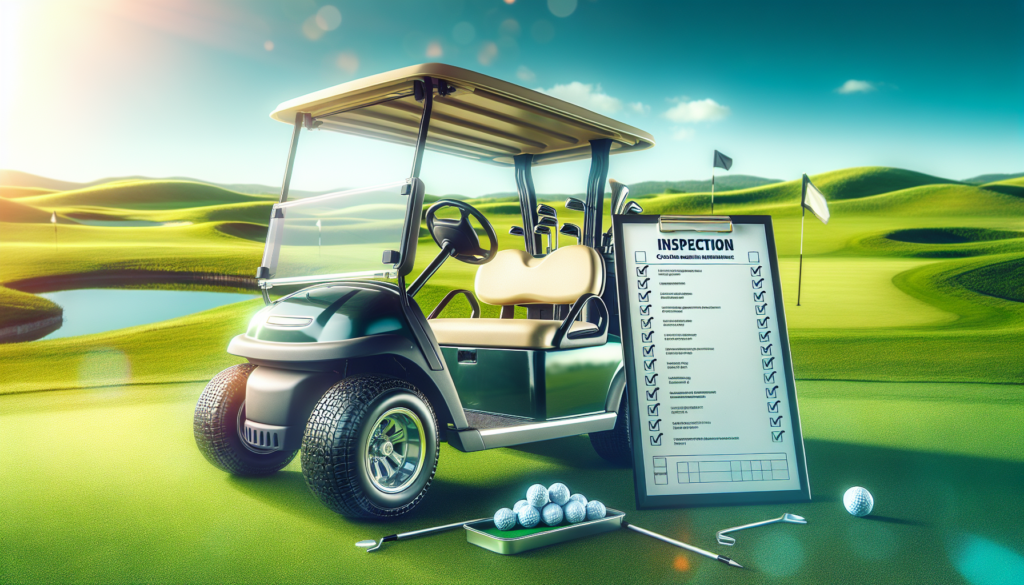Navigating the world of golf cart ownership can be quite tricky without the right knowledge in place. There’s often one persistent question on the minds of those considering buying a golf cart: what exactly are the maintenance requirements? So, let’s cut through the noise and uncertainty. Drawing from industry expertise, we’re going to shed light on the upkeep demands of a golf cart, helping you sail smoothly into informed ownership.
Understanding Battery Maintenance
Maintaining the battery in excellent condition is crucial for the efficient operation of your golf cart. Regular battery maintenance can prolong the life of your golf cart’s battery and can enhance its performance.
Checking and Refilling Water Levels
The water level in your golf cart battery needs to be checked regularly. We recommend doing this at least once a month. If the water level is low, it should be refilled with distilled water. Refilling should be done carefully to avoid overfilling. It’s important not to let the battery plates be exposed to air as this can result in permanent damage.
Cleaning Battery Terminals and Cables
Over time, battery terminals and cables may accumulate corrosion, which impedes flow of electricity and can lead to diminished performance of your golf cart. Regular cleaning involves removing the cables, scrubbing the terminals with a wire brush, and rinsing with a solution of baking soda and water. After thoroughly drying, apply a bit of terminal protectant to prevent future corrosion.
Charging Protocols and Practices
Proper charging of your golf cart battery is essential for its lifespan and efficiency. It’s important to charge the battery immediately after use and avoid draining the battery completely. Always use the charger that comes with your golf cart as it’s designed specifically for your battery. Charging in a well-ventilated area is essential as the charging process can generate gases.
Battery Replacement Tips and Lifespan
When the time comes to replace your golf cart battery, it is crucial to choose the right model that fits your golf cart’s motor voltage. Also, always replace batteries in sets to avoid damaging new batteries. Replacement should be done at least every 5-7 years, but battery lifespan can be extended with proper maintenance.
Importance of Tire Care
Regular tire care is crucial in ensuring the safety and comfort of your golf cart ride. It ensures better traction, fuel efficiency, and overall performance of the golf cart.
Regular Tire Pressure Checks
Maintaining the right tire pressure improves traction, reduces tire wear, and increases overall performance. We recommend checking the pressure at least once a month and before long rides. The recommended pressure can be found in the golf cart’s user manual.
Tread Wear Inspection
Tread wear should be monitored regularly to ensure the tires maintain proper traction. Uneven wear might indicate a need for wheel alignment. If the tread is excessively worn, it’s time to replace your tires.
Wheel Alignment and Balancing
Misaligned or unbalanced wheels can cause uneven tire wear, shaking, and difficulties steering. It’s best to have your golf cart’s wheels professionally aligned and balanced if you’re experiencing any of these issues.
Replacing Tires and Rotation Schedule
Tires should be replaced when the tread is worn down to 1/16th of an inch in depth. Regular rotation of the tires extends their lifespan and ensures even wear. We recommend rotating them every 5000 miles.

Regular Electrical System Checks
Stay on top of your golf cart’s electrical performance with regular inspections.
Inspecting Wiring and Connectors
Maintaining the integrity of your golf cart’s electrical system involves checking for exposed wires, corrosion on connectors, and damaged insulation. Inspections should be carried out regularly and repairs undertaken immediately to avoid potential hazards.
Troubleshooting Common Electrical Issues
Common electrical issues include dim headlights, slow performance, or the inability to start. Such issues could point to a failing battery, damaged wiring, or deteriorating electrical components. Proper diagnosis is essential to implement the right solution.
Regularly Testing the Starter and Generator
The starter and generator play crucial roles in your golf cart’s operation. Regular testing can preemptively identify issues before they cause significant problems. It’s best to leave these tests to professional technicians for accurate results.
The Steering System and Front End
Proper maintenance of the steering system protects your golf cart from unnecessary wear and tear and guarantees optimal performance.
Lubrication of Steering Components
Lubrication of the steering box, tie rod ends, and kingpins reduces friction between these parts and prolongs their lifespan. We recommend lubrication every six months or according to the manufacturer’s instructions.
Front Suspension Inspection
Regular inspections of the front suspension can identify issues like worn rubber bushings, loose bolts, or leaking shocks. Prompt replacement or repair helps ensure a smooth and reliable ride.
Tightness and Condition of Steering Rack
A loose steering rack can lead to difficulties controlling your golf cart. Regularly checking for looseness and making necessary adjustments will keep steering accurate and responsive.

Brake System Maintenance
A well-maintained brake system ensures the safety of you and your passengers by ensuring prompt and effective stops.
Brake Pad Inspection and Replacement
Regular checking of brake pads for wear and tear is crucial. Replacement should be done once the pads are worn down to a quarter of an inch for effective braking performance.
Checking and Refilling Brake Fluid
The brake fluid leve should be checked regularly, and the fluid should be replaced every two years or according to the manufacturer’s recommendations. It’s also a good idea to check for signs of leaking fluid.
Brake Cable Adjustment and Replacement
Brake cables that are too tight or too loose might drastically impair your braking performance. Regular adjustments ensure consistent and safe brake operations.
Inspecting and Servicing Brake Drums
Brake drums should be inspected and cleaned regularly to keep them free of dust and rust. If they’re worn down or damaged, it’s time for replacement.
Greasing and Lubrication
Greasing and lubricating your golf cart protects it from wear and tear and keeps it running smoothly.
Identifying Grease Points
Key spots to grease include wheel bearings, springs, pedal clusters, and numerous other moving parts. Check the manufacturer’s diagram for your specific vehicle to identify all the grease points.
Axles, Hubs
Axles and hubs need to be lubricated regularly to minimize friction and prevent damage. We recommend doing this every six months or as suggested by the manufacturer.
Greasing Schedule
A regular greasing schedule is beneficial for the smooth running of your golf cart. Grease points should be maintained monthly or according to the instructions provided by your golf cart’s manufacturer.
Cleaning and Detailing
Regular cleaning and detailing not only keep your golf cart looking great but also protect it from the elements and prolong its lifespan.
Routine Cleaning Schedule
We recommend a thorough cleaning at least once a month. Use a soft cloth and mild detergent to clean the body, canopy, and seats.
Waxing and Protecting Exterior Surfaces
Waxing after cleaning provides an added layer of protection from UV rays and other environmental hazards. A good quality wax should be applied every three to six months.
Upholstery and Seat Care
Clean seats not only look good, but they also promote the longevity of the material. Cleaning and conditioning the upholstery can prevent cracking and fading due to exposure to the elements. Waterproof covers can provide an added layer of protection.
Cleaning and Protection for Windshields and Canopies
The windshield and canopy need to be cleaned regularly for clear visibility and to prevent scratching. Use a soft cloth and a non-abrasive cleaner, and ensure you rinse thoroughly.
Golf Cart Body and Frame Care
Regular inspections of your golf cart’s body and frame can help you catch and address damage early.
Inspecting for Structural Damage
Inspecting for visible cracks, rust, and stress points is necessary to guarantee the safety and durability of your golf cart. Regularly check both the underframe and the body for any signs of structural damage.
Repair and Replacement of Body Panels
Should you find any damaged panels during your inspections, prompt repairs or replacement prevent further degradation of your golf cart’s body.
Rust Prevention and Treatment
Rust can severely damage the framework. Regular rust checks, appropriate treatments, and preventative measures like keeping your golf cart away from high humidity or salty environments can forestall serious rust problems.
Engine or Motor Maintenance
Proper care of your golf cart’s engine or motor is the key to maintaining its performance and durability.
Routine Engine Checkup
Frequent engine checkups can help identify potential issues early. Pay attention to the sound, vibrations, and performance of your golf cart.
Spark Plug Inspection and Replacement
Spark plugs play a vital role in a gas golf cart. Check them every year for carbon deposits, cracks, and other damages. Replace if necessary for optimal engine performance.
Motor Brush Inspection for Electric Golf Carts
Motor brushes are a crucial part of electric golf carts and should be inspected once a year. If they’re worn down excessively, it’s time for a replacement.
Oil Changes for Gas-Powered Golf Carts
Regular oil changes ensure that your engine runs smoothly and efficiently. We recommend performing an oil change every year or after 125 hours of running.
Seasonal and Storage Procedures
Proper procedures for seasonal use or long-term storage of your golf cart can prolong its life.
Winterization for Cold Climates
For golf carts in cold climates, winterization is vital. This includes battery maintenance, protecting your golf cart from moisture and snow, and using a golf cart cover.
Battery Maintenance During Off-Season
When the golf cart is not in use, ensure to check and maintain the battery. Disconnect it and keep it charged to avoid freezing and potential battery damage.
Moisture and Pest Control During Storage
It’s crucial to protect your golf cart from moisture and pests during storage. Use breathable golf cart covers and take steps to protect the area where the cart is stored. Check your golf cart for any animal nests or signs of pest infestations.
Performing regular maintenance on your golf cart not only ensures you enjoy smooth and efficient rides but also extends the lifespan of the golf cart. Invest time and effort now, and you’ll reap the rewards in the long run with a reliable, enduring golf cart that’s ready to perform whenever you need it.




